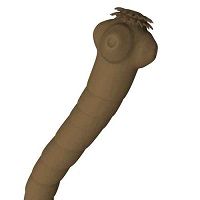Article
CDC Alarmed by US Tapeworm Brain Infections
Author(s):
Seizures and other neurological problems traced to pork tapeworms are a new health threat for the US, the CDC reports.

A brain infection caused when cysts harboring larvae from pork tapeworms develop in the human brain has long been a problem in undeveloped nations.
In an alert sounded today by the US Centers for Disease Control and Prevention (CD) the agency reports that 18,584 US residents were hospitalized with the condition, known as neurocysticerosis, from 2003 to 2012. The numbers have fluctuated from a high of 2,247 in 2006 to a low of 1,495 in 2012, but the surprising finding was that the condition has become a significant health issue in the US.
There were twice as many hospitalizations for neurocysticerosis as there were for malaria in the years studied, the CDC noted.
The 2-part cycle of infection is completed when people ingest the tapeworms’ larvae from infected pigs, usually by eating undercooked pork. The full cylce is explained here. The larvae grow into tapeworms in the human intestinal tract, reaching lengths of 2m to 4 m. The mature tapeworms produce eggs that are excreted in feces.
If these eggs are consumed through the oral-fecal route they then migrate throughout the body, including to the human brain, where infection causes neurological symptoms including epilepsy, seizures, headache, obstructive hydrocephalus, encephalitis, stroke and cognitive and other mental health disorders, Oregon Health & Science University researchers Seth O’Neal and Robert Flecker reported to the CDC. The cycle of infection can be repeated if pigs consume food contaminated by feces from infected humans. For that reason the disease is endemic in poor rural communities in Latin America, sub-Saharan Africa and Asia.
“However the disease is also of increasing public health concern in the US,” the researchers wrote, both in the immigrant population and in people who have traveled to regions where the illness in endemic. In the study years the infections costs $908 million in US hospital costs.
The infections were most common in the western US (42.9% of cases), followed by the southern US (31.8%) the northeastern US (15.5%) and the Midwestern Us (9.8%).
The authors note that the illness could be underestimated since only 6 states require it to be reported (Alaska, Arizona, California, New Mexico, Oregon, and Texas).
Most of the patients hospitalized were admitted for epilepsy or convulsions (57.3% of the hospitalizations).
In some stages the infection can be treated by drugs, but surgery to remove the cysts or implanting shunts to relieve the pressure of hydropcephalus may be necessary.




